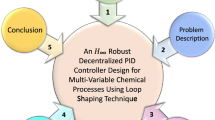Abstract
This work presents a comparison among three different control strategies for multivariable processes. The techniques were implemented in a pilot plant with coupled control loops, where all steps used to design the controllers were described allowing to establish a trade-off between algorithm complexity, information needed from the process and achieved performance. Two data-driven control techniques are used: multivariable ultimate point method to design a decentralized PID controller and virtual reference feedback tuning to design a centralized PID controller. A mathematical model of the process is obtained and used to design a model-based generalized predictive controller. Experimental results allow us to evaluate the performance achieved for each method, as well as to infer on their advantages and disadvantages.












Similar content being viewed by others
Notes
For PID controller parameters see Campestrini et al. (2009).
References
Al-Naumani, Y., & Rossiter, J. (2015). Distributed MPC for upstream oil & gas fields—A practical view. In 9th IFAC symposium on advanced control of chemical processes ADCHEM 2015 (Vol. 48, pp. 325–330).
Åstrom, K. J., & Hägglund, T. (1995). PID controllers: Theory, design and tuning (Vol. 2). NC: Isa Research Triangle Park.
Åström, K. J., & Wittenmark, B. (1997). Computer-controlled systems: Theory and design. Upper Saddle River: Prentice-Hall.
Bi, Q., Wang, Q. G., & Hang, C. C. (1997). Relay-based estimation of multiple points on process frequency response. Automatica, 33(9), 1753–1757.
Bodson, M., & Groszkiewicz, J. E. (1997). Multivariable adaptive algorithms for reconfigurable flight control. IEEE Transactions on Control Systems Technology, 5(2), 217–229.
Camacho, E. F., & Bordons Alba, C. (2007). Model predictive control. Advanced textbooks in control and signal processing. London: Springer.
Campestrini, L., Barros, P., & Bazanella, A. (2006). Auto-tuning of PID controllers for MIMO processes by relay feedback. In IFAC symposium on advance control of chemical processes (pp. 451–456). Gramado, RS, Brazil.
Campestrini, L., Stevanatto Filho, L. C., & Bazanella, A. S. (2009). Tuning of multivariable decentralized controllers through the ultimate-point method. IEEE Transactions on Control Systems Technology, 17(6), 1270–1281.
Campestrini, L., Eckhard, D., Chía, L. A., & Boeira, E. (2016). Unbiased MIMO VRFT with application to process control. Journal of Process Control, 39, 35–49.
Campi, M., Lecchini, A., & Savaresi, S. (2002). Virtual reference feedback tuning: A direct method for the design of feedback controllers. Automatica, 38, 1337–1346.
Clarke, D. W., Mohtadi, C., & Tuffs, P. S. (1987). Generalized predictive control—Part I. The basic algorithm. Automatica, 23(2), 137–148.
Dumont, G. A. (1986). Application of advanced control methods in the pulp and paper industry—A survey. Automatica, 22(2), 143–153.
García, C., Prett, D., & Morari, M. (1989). Model predictive control: Theory and practice—A survey. Automatica, 25(3), 335–348.
Hjalmarsson, H., Gevers, M., Gunnarsson, S., & Lequin, O. (1998). Iterative feedback tuning: Theory and applications. IEEE Control Systems Magazine, 18(4), 26–41.
Jin, Q., Hao, F., & Wang, Q. (2013). A multivariable IMC-PID method for non-square large time delay systems using npso algorithm. Journal of Process Control, 23(5), 649–663.
Karimi, A., Mišković, L., & Bonvin, D. (2004). Iterative correlation-based controller tuning. International Journal of Adaptive Control and Signal Processing, 18, 645–664.
Krstic, M., Kanellakopoulos, I., & Kokotovic, P. V. (1995). Nonlinear and adaptive control design. Hoboken: Wiley.
Loh, A. P., Hang, C. C., Quek, C. K., & Vasnani, V. U. (1993). Autotuning of multiloop proportional-integral controllers using relay feedback. Industrial & Engineering Chemistry Research, 32(6), 1102–1107.
Luyben, W. L. (1986). Simple method for tuning SISO controllers in multivariable systems. Industrial & Engineering Chemistry Process Design and Development, 25, 654–660.
Maciejowski, J. M. (1989). Multivariable feedback design. Electronic systems engineering series. Wokingham: Addison-Wesley.
Mehta, U. (2013). Fast Fourier transform for estimating process frequency response. In 2013 IEEE 8th conference on industrial electronics and applications (ICIEA), IEEE, (pp. 7–10).
Palmor, Z. J., Halevi, Y., & Krasney, N. (1995). Automatic tuning of decentralized pid controllers for TITO processes. Automatica, 31(7), 1001–1010.
Rojas, J., Morilla, F., & Vilanova, R. (2012). Multivariable PI control for a boiler plant benchmark using the virtual reference feedback tuning. In 2nd IFAC conference on advances in PID control, (pp. 376–381).
Skogestad, S., & Postlethwaite, I. (2005). Multivariable feedback control: Analysis and design. Hoboken: Wiley.
Söderström, T., & Stoica, P. (1988). System identification. Upper Saddle River: Prentice-Hall.
Vu, T. N. L., & Lee, M. (2010). Independent design of multi-loop PI/PID controllers for interacting multivariable processes. Journal of Process Control, 20(8), 922–933.
Wang, Q. G., Bi, Q., & Zou, B. (1997). Use of FFT in relay feedback systems. Electronics Letters, 33(12), 1099–1100.
Yubai, K., Usami, H., & Hirai, J. (2009). Correlation-based direct tuning of MIMO controllers by least-squares and its application to tension-and-speed control apparatus. In ICCAS-SICE, IEEE (pp. 931–936), Fukuoka, Japan.
Ziegler, J. G., & Nichols, N. B. (1942). Optimum settings for automatic controllers. Journal of Dynamic Systems, Measurement, and Control, 115(2B), 220–222.
Author information
Authors and Affiliations
Corresponding author
Additional information
E. Boeira, V. Bordignon, D. Eckhard and L. Campestrini are supported by CNPq.
Rights and permissions
About this article
Cite this article
Boeira, E., Bordignon, V., Eckhard, D. et al. Comparing MIMO Process Control Methods on a Pilot Plant. J Control Autom Electr Syst 29, 411–425 (2018). https://doi.org/10.1007/s40313-018-0387-6
Received:
Revised:
Accepted:
Published:
Issue Date:
DOI: https://doi.org/10.1007/s40313-018-0387-6




